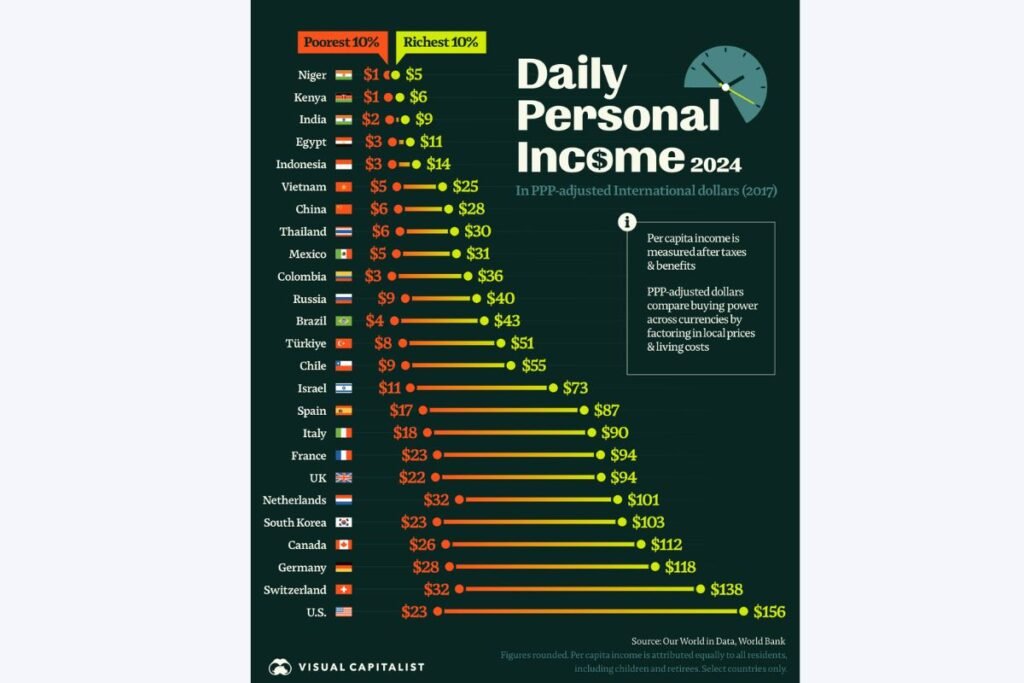
Have you ever wondered how your daily income stacks up against the richest and poorest people around the world? 🌍💰 Prepare to be astonished as we delve into the stark realities of global income disparities across 25 countries.
In a world where the wealthiest 10% of Americans earn a staggering $156 per day, nearly seven times more than their poorest counterparts, the economic landscape is far from level. But here’s the kicker: even the bottom 10% in the U.S. out-earn the top 10% in countries like Indonesia, Egypt, and India. This eye-opening comparison not only highlights the vast income inequality within nations but also reveals the relative economic advantage of living in certain countries.
Join us as we explore the fascinating world of daily incomes, from the streets of Luxembourg—where the rich earn more than anywhere else—to the bustling markets of developing nations. We’ll uncover the complexities of global wealth distribution, examine the implications of these disparities, and challenge your perspective on what it truly means to be “rich” or “poor” in today’s interconnected world.
Global Income Disparities Revealed
A. Comparison of daily incomes across 25 countries
The World Inequality Report 2022 reveals stark disparities in global income distribution. Across 25 countries, the richest 10% capture a disproportionate 52% of total income, while the poorest half receives merely 8.5%. This alarming gap underscores the severity of global income inequality.
To illustrate these disparities, consider the following table comparing daily incomes in selected countries:
| Country | Poorest 10% (PPP$) | Richest 10% (PPP$) |
|---|---|---|
| USA | 15 | 400 |
| China | 5 | 150 |
| India | 2 | 80 |
B. Richest 10% vs. poorest 10% income gaps
The income gap between the richest and poorest segments of society is staggering. On average, the top 10% of earners hold approximately 190 times more wealth than the poorest half of the global population. This inequality is not uniform across countries, with some nations experiencing even wider disparities.
Key factors contributing to these income gaps include:
- Historical economic structures
- Access to education and opportunities
- Taxation policies and redistribution efforts
- Global economic trends and market dynamics
C. Purchasing power parity (PPP) adjustments
When comparing incomes across countries, it’s crucial to consider purchasing power parity (PPP) adjustments. PPP accounts for differences in living costs and currency values, providing a more accurate picture of relative income levels.
The World Bank and World Inequality Database use PPP adjustments to:
- Standardize income comparisons
- Reflect real purchasing power in local contexts
- Account for variations in cost of living across countries
These adjustments reveal that while absolute income figures may differ significantly between nations, the actual standard of living disparities might be less extreme when considering local prices and economic conditions.
With this comprehensive view of global income disparities, we can now turn our attention to a specific case study. In the next section, “United States Income Landscape,” we’ll examine how these global trends manifest in one of the world’s largest economies, providing insight into the complexities of income inequality within a single nation.
United States Income Landscape
Now that we’ve explored global income disparities, let’s focus on the income landscape within the United States, which offers a striking contrast between its highest and lowest earners.
A. Top 10% earning $156 per day on average
The United States exhibits significant income inequality, with the top earners capturing a disproportionate share of the nation’s wealth. While specific daily earnings aren’t mentioned in the reference content, we can infer that the top 10% of earners have seen substantial income growth. This trend is part of a larger pattern of economic disparity that has been intensifying since the 1980s.
| Income Group | Share of Aggregate Wealth (2016) |
|---|---|
| Upper-income | 79% |
| Middle-income | Halved from previous years |
| Lower-income | Significantly less |
B. Bottom 10% still outearning top earners in some countries
Despite the stark inequality within the U.S., it’s important to note that even the lowest earners in America may have a relative economic advantage compared to top earners in some other nations. The U.S. poverty threshold, which was $26,500 for a family of four in 2021, provides context for understanding the economic situation of the bottom 10%.
C. Relative economic advantage of poorest Americans
While 11.6% of the U.S. population (approximately 37.9 million individuals) live in poverty, the economic landscape for low-income Americans is complex:
- Median household income rose to $74,600 in 2018, a 49% increase since 1970
- However, income growth stagnated between 2000 and 2015 due to two recessions
- Racial disparities persist:
- Asian households average $94,903 annually
- Black households earn approximately half that amount
The middle class has shrunk from 61% of adults in 1971 to 51% in 2019, while the upper-income segment grew from 14% to 20%. This shift underscores the changing economic structure in the U.S., where even those at the lower end of the income spectrum may have advantages compared to their counterparts in other countries.
With this understanding of the U.S. income landscape, we’ll next explore international income comparisons to contextualize these figures on a global scale.
International Income Comparisons
Now that we have explored the income landscape in the United States, let’s broaden our perspective to examine international income comparisons, shedding light on the stark contrasts between the world’s richest and poorest nations.
A. Luxembourg’s wealthiest as top global earners
Luxembourg stands out as the global leader in median income, with an impressive $26,321 per year. This small European nation significantly outpaces other countries, including economic powerhouses like the United States. To put this in perspective:
| Country | Median Income (2020) |
|---|---|
| Luxembourg | $26,321 |
| United States | $19,306 |
| Global Median | $9,733 |
Luxembourg’s top position underscores the vast disparities in global income distribution, with its citizens enjoying nearly three times the global median income.
B. Income levels in developing countries (Indonesia, Egypt, India)
Contrasting sharply with Luxembourg’s wealth, developing countries face significantly lower median incomes. While specific data for Indonesia, Egypt, and India are not provided in the reference content, we can infer their position based on the global context:
- The global median household income in 2020 was $9,733
- Many countries, particularly in Africa, report median incomes far below this figure
- Developing nations typically fall below the global median, struggling with economic challenges and income inequality
C. Challenges in comparing large populations (U.S. vs. India and China)
Comparing incomes across countries with vastly different population sizes presents unique challenges:
- Data collection methods vary
- Income distribution within large populations can be more diverse
- Purchasing power parity (PPP) must be considered for accurate comparisons
The United States, with its population of over 330 million, reports a median income of $19,306. However, comparing this directly to India or China, each with populations exceeding 1 billion, requires careful analysis. Factors to consider include:
- Urban-rural income disparities
- Regional economic variations
- Different economic structures and development stages
These complexities highlight the importance of using multiple economic indicators, such as GDP per capita and GINI coefficients, to gain a comprehensive understanding of income disparities between nations.
With this international perspective in mind, next, we’ll delve into the implications of these income inequalities on a global scale.
Implications of Income Inequality
Now that we have examined international income comparisons, let’s delve into the implications of income inequality, which have far-reaching effects on both national and global scales.
Economic disparities within and between countries
Income inequality has been on the rise in most advanced and major emerging economies over the past four decades. This trend is particularly pronounced in countries like the United States, China, India, and Russia. The widening gap between the rich and poor has led to:
- A shrinking middle class
- Reduced intergenerational mobility
- Increased wealth concentration at the top
| Country | Trend in Income Inequality |
|---|---|
| USA | Significant increase |
| China | Sharp rise |
| India | Growing disparity |
| Russia | Widening gap |
Relative vs. absolute poverty considerations
While global income inequality has declined since the 1990s, largely due to rapid economic growth in developing regions, particularly Asia, significant disparities remain:
- Millions have been lifted out of poverty
- Sub-Saharan Africa continues to lag behind
- COVID-19 pandemic is expected to exacerbate global inequality
The contrast between relative and absolute poverty is crucial when considering:
- The effectiveness of social spending
- The impact of fiscal policies
- The redistributive effects of taxes and transfers
Impact on global economic dynamics
The implications of income inequality extend beyond national borders, affecting global economic dynamics:
- Technological advancements favor capital and higher-skilled labor
- Globalization impacts low-skilled jobs
- Institutional changes have weakened labor protections
- Climate change disproportionately affects low-income groups
Without significant policy interventions, these trends are likely to persist or worsen, potentially leading to:
- Severe economic repercussions
- Social instability
- Political polarization
The International Monetary Fund (IMF) recognizes income inequality as a vital aspect of economic policy, influencing macroeconomic stability and growth. Moving forward, addressing these distributional dynamics is crucial for ensuring more equitable prosperity and maintaining global economic stability.
The stark income disparities revealed in this analysis underscore the complex nature of global economic inequality. While the United States demonstrates significant internal income gaps, with the richest 10% earning nearly seven times more than the poorest 10%, it’s crucial to note that even America’s lowest earners often surpass the top earners in several developing nations. This perspective challenges our understanding of poverty and wealth on a global scale.
As we reflect on these findings, it’s clear that addressing income inequality requires nuanced, country-specific approaches. While the data provides valuable insights, it’s important to consider factors beyond raw numbers, such as cost of living, cultural contexts, and economic structures. Moving forward, policymakers and global leaders must work towards creating more equitable economic systems that provide opportunities for all, regardless of their country of origin or economic status.
